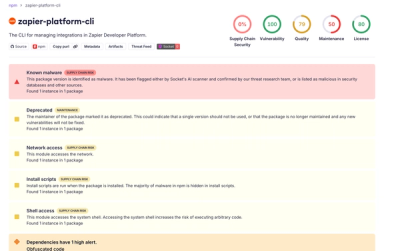
Research
/Security News
Shai Hulud Strikes Again (v2)
Another wave of Shai-Hulud campaign has hit npm with more than 500 packages and 700+ versions affected.
easy-vault
Advanced tools
.. image:: https://badge.fury.io/py/easy-vault.svg :target: https://pypi.python.org/pypi/easy-vault/ :alt: Version on Pypi
.. image:: https://github.com/andy-maier/easy-vault/workflows/test/badge.svg?branch=master :target: https://github.com/andy-maier/easy-vault/actions/ :alt: Actions status
.. image:: https://readthedocs.org/projects/easy-vault/badge/?version=latest :target: https://readthedocs.org/projects/easy-vault/builds/ :alt: Docs build status (master)
.. image:: https://coveralls.io/repos/github/andy-maier/easy-vault/badge.svg?branch=master :target: https://coveralls.io/github/andy-maier/easy-vault?branch=master :alt: Test coverage (master)
The easy-vault Python package provides commands for encrypting and decrypting vault files that can be in any format. It provides for programmatic access to encrypted vault files from Python programs, so that the file itself can stay encrypted in the file system but can still be used by the program in clear text.
At first use on a particular vault file, the encryption command prompts for a
vault password and stores that in the keyring service of your local system
using the keyring package_. Subsequent encryption and decryption of the vault
file will then use the password from the keyring, avoiding any further password
prompts. Programmatic access can also be done with the password from the
keyring.
The encryption of the vault files is implemented using the symmetric key
functionality of the cryptography package_.
One use case for this package is for example the daily work with programs that need the secrets from a vault to access some server or service. For that, the program in question needs to have integrated with this package.
Another use case is testing in CI/CD systems: The encrypted vault file is stored in a repository and the password to access it is put as a secret into the CI/CD system (most CI/CD systems these days support storing secrets in a secure way). The test program uses the vault password from the CI/CD secret to get access to the vault to get to the secrets that are needed to perform the tests. One could have put the vault secrets directly into the CI/CD system, but if the vault file is also used for local work, or if the number of secrets is large or has a complex structure, it is better to have the indirection of the vault file.
The vault files stay encrypted in the file system while they are used, and are only decrypted and re-encrypted in the file system when secrets need to be updated/added/removed.
This package allows putting at rest the habit of having clear text files that contain passwords, API keys and other secrets, and allows transitioning to a secure but still easy to use approach for managing such secrets.
Why a new vault implementation: The ansible-vault command provided the functionality we needed and was originally used (except for the keyring storage which we added). However, Ansible does not support native Windows and that was a requirement. Also, the ansible-vault command requires installing the entire Ansible which is quite large. Searching Pypi for suitable vaults that a) have commands for encrypting and decrypting and b) provide programmatic access to the encrypted file, did not reveal anything suitable.
.. _Documentation and change log:
Documentation_Change log_The easy-vault package is provided under the
Apache Software License 2.0 <https://raw.githubusercontent.com/andy-maier/easy-vault/master/LICENSE>_.
.. # Links:
.. _Documentation: https://easy-vault.readthedocs.io/en/stable/
.. _Change log: https://easy-vault.readthedocs.io/en/stable/changes.html
.. _keyring package: https://github.com/jaraco/keyring/blob/main/README.rst
.. _cryptography package: https://cryptography.io/en/stable/
FAQs
Secure vault files that are easy to use
We found that easy-vault demonstrated a healthy version release cadence and project activity because the last version was released less than a year ago. It has 1 open source maintainer collaborating on the project.
Did you know?

Socket for GitHub automatically highlights issues in each pull request and monitors the health of all your open source dependencies. Discover the contents of your packages and block harmful activity before you install or update your dependencies.

Research
/Security News
Another wave of Shai-Hulud campaign has hit npm with more than 500 packages and 700+ versions affected.

Product
Add real-time Socket webhook events to your workflows to automatically receive software supply chain alert changes in real time.

Security News
ENISA has become a CVE Program Root, giving the EU a central authority for coordinating vulnerability reporting, disclosure, and cross-border response.